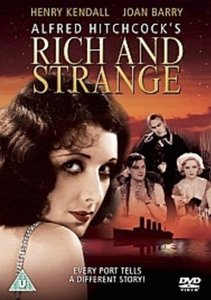After middling creative success with what today play like filmed theatrical works early in the sound era, Alfred Hitchcock opens up to the medium’s potential in “Rich and Strange” (1931). Ironically, he does so by returning to silent-era principles. This light but grand romantic drama wears its emotions on the expressions of the performers as much as in lines of dialog, and the film even includes intertitles.
Love rectangle
Known as “East of Shanghai” for its USA release, this fifth talkie in his oeuvre again finds Hitchcock trying to fit his sense of playfulness into dramatic scenarios, something that falls flat in “Murder!” and “The Skin Game.” It plays much better here, starting with a silent-style opening wherein office worker Fred (Henry Kendall) slogs home amid a maddening crowd.
On the subway, he barely has room to open his newspaper. In the rain, his umbrella won’t open – until he’s home and already soaked. Then we see his wife is the delightful Emily (Joan Barry, who did the uncredited voice work for Anny Ondra in “Blackmail”), and we feel a little less bad for this sad sack.

“Rich and Strange” (1931)
Director: Alfred Hitchcock
Writers: Alfred Hitchcock (adaptation); Alma Reville, Val Valentine (scenario); Dale Collins (novel)
Stars: Henry Kendall, Joan Barry, Percy Marmont
The title suggests Hitchcock is taking a one-film break from serious life struggles, but we can see Fred and Em are workaday folks. When Fred’s uncle gives him an early inheritance so the couple can travel the world, we’re happy for them.
And Hitch has found a way to be cinematic, taking the production to France and Egypt and also using ambitious soundstage construction at Elstree Studios (namely a sinking boat, shades of “Foreign Correspondent”) to chronicle the couple’s journey from London to Shanghai and back again.
When it becomes a love rectangle, “Rich and Strange” takes off with a subtly rich and strange narrative. By unspoken agreement, the seasick Fred allows Em to hang out with gentleman Commander Gordon (Percy Malmont). And once he’s better, Fred strikes it up with a foreign princess (Betty Amann).
Barry is Barry good to the film
Shipboard conversations and seaport ventures for these new pairings are surprisingly enjoyable. The relaxed Gordon describes the precocious Em as “delicious” and it’s not gross; there’s a genuine innocence to their chats about love and loneliness. The story of the princess getting her claws into Fred is likewise believable, but with a darker undertone. In this case the chemistry is not there, but that’s a hint to viewers, not a casting flaw.
For the first time in the sound era, Hitch’s playful humor comes through because “Rich and Strange” has a strong sense of casting, character and chemistry. The unsung hero is Elsie Randolph as Miss Emory, who amusingly tries her hand at every eligible and ineligible bachelor on the ship. This role is sometimes referred to as “The Old Maid,” but it might’ve been sad to see an older woman in the part; the casting of the cute Randolph (slightly younger than Barry) gives us permission to laugh.

While the movie is too slowly paced at times, it more often has a pleasantly relaxed momentum. Few sequences are boring wastes of celluloid, as found in Hitch’s previous few efforts. Admittedly, this is helped by the fact that we could watch Barry organize her closet and be smitten.
The picture almost slots in as a delightful travelog, as we go from Paris nightlife to the bustling rug market of Said. But a weird final act knocks it back a peg. When their cruise ship begins to sink, Fred and Em are rescued by a Chinese junk. Hitch focuses on the alienness of the Chinese, who watch a colleague drown without trying to save him, and capture and dine on a stray cat. Suffice it to say that this part of the film is not awfully P.C.
“Rich and Strange” isn’t a grand triumph, but it’s an important threshold. Hitchcock recognizes that it’s OK to have stretches of silence in talkies, and have people talk only when it means something. Between the words, he relearns, images can say a lot.
RFMC’s Alfred Hitchcock series reviews works by the Master of Suspense, plus remakes and source material. Click here to visit our Hitchcock Zone.

